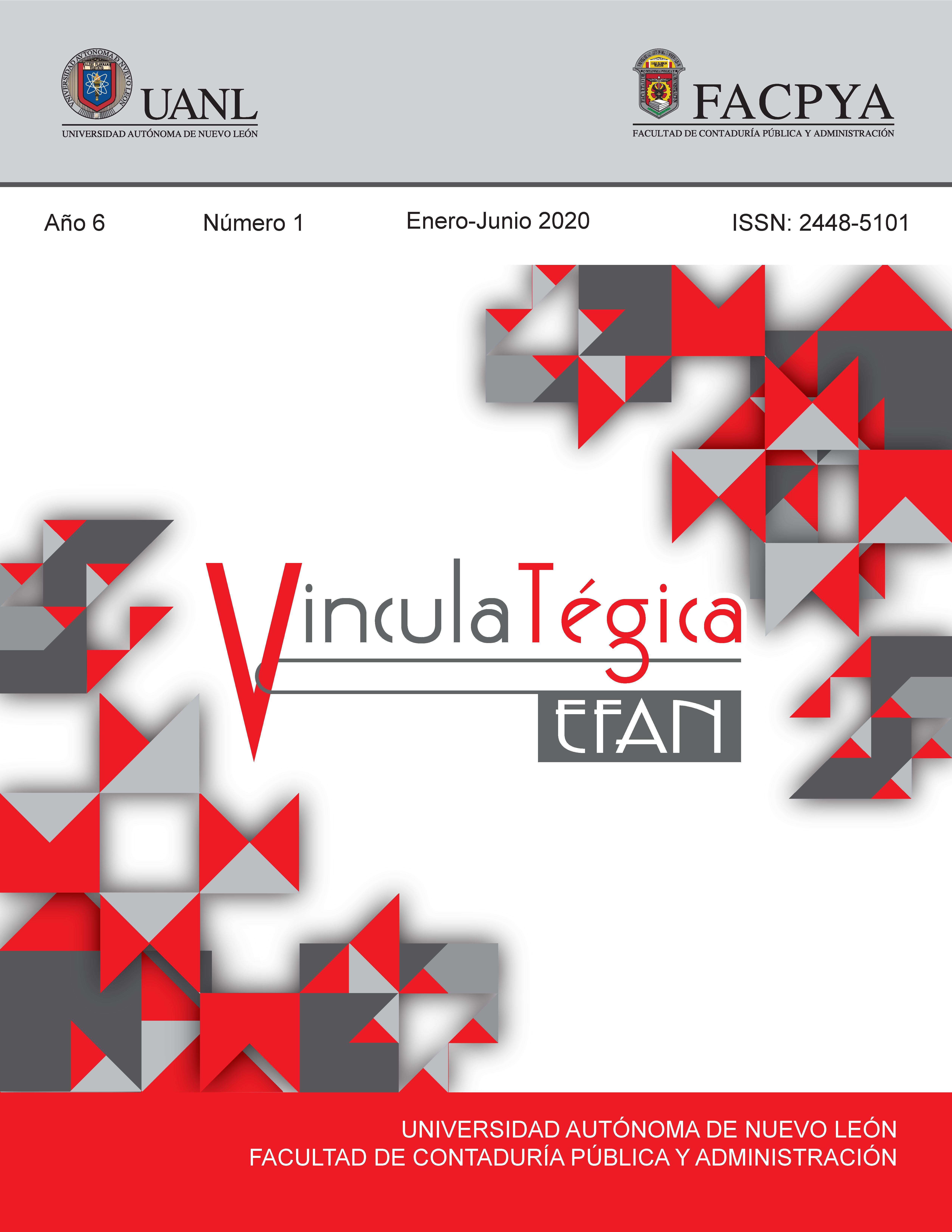Propuesta metodológica para medir el impacto de la implementación de un sistema contable en la productividad de empresas financieras
DOI:
https://doi.org/10.29105/vtga6.1-573Keywords:
Productividad, TICS, software, contrafactual, hojas de tiemposAbstract
The purpose of this work is to propose a methodology that
serves as a tool to measure the impact on productivity
resulting from updating or changing TICS (software) in
service companies, based on the Impact Assessment
methodology Counterfactual called Pre-Post (before and
after), which focuses on contrasting two scenarios, one
before the application of the variable vs after, to assess
whether the impact was positive or negative by using
productivity indicators. As a result, various formats were
designed to help contrast, as well as the construction of
indicators for its application, which will allow companies
to evaluate the new technology and thus have the basis to
carry out some strategic action to be Necessary.
Downloads
References
Alvarez F. (2015). Implementación de nuevas Tecnologías: Valuación, variables, riegos y escenarios tecnológicos. San Salvador, El Salvador: UFG Editores.
Bharadwaj, A.S. (2000). A resource-based perspective on information technology capability and firm performance: an empirical investigation. MIS Quarterly. 24(1), 169-196. DOI: https://doi.org/10.2307/3250983
Chen, J.S. Tsou, H.T. (2012). Performance effects of IT capability, service process, innovation and the mediating role of customer service. Journal of Engineering and Technology Management, 29(1) 71- 94. DOI: https://doi.org/10.1016/j.jengtecman.2011.09.007
Christopher, W. (1993). Handbook for productivity measurement and improvement. Portland, Estados Unidos: Productivity Press.
Clemons, E., y Row, M. (1991). Sustaining IT Advantage: The role of Structural differences. Management Information Systems Research Center, University of Minnesota. 15(3), 275-292. DOI: https://doi.org/10.2307/249639
Garcia, B. (2005). El paradigma Nueva Economía: Mitos y realidades. Scielo. 2(5), 1-20. Recuperado de: http://www.scielo.org.mx/scielo.php?script=sci_arttext&pid=S1665-952X2005000200007
Gertler, P.J., Martínez, S., Premand, P., Rawlings, L.B. y Vermeersch, G.M. (2017). La evaluación de impacto en la práctica. Wachington, Estados Unidos: Banco Interamericano de Desarrollo y Banco Mundial. DOI: https://doi.org/10.1596/978-1-4648-0888-3
Grant, R.M. (1991). The resource-based theory of competitive advantage. California Management Review. 33(3), 114-135. DOI: https://doi.org/10.2307/41166664
Hernandez, D. (2015). Estudio de tiempos y movimientos en la empresa. Germenstartup. 1(1), 1-3. Recuperado de: https://germenstartup.wordpress.com/2015/01/12/estudio-de-tiempos-y movimientos-en-la-empresa/
Karimi, J., Somers, T.M., y Bhattacherjee, A. (2007). The role of information systems resources in EPR capability building and business process outcomes. Journal of Management Information Systems. 24(2). 221-260. DOI: https://doi.org/10.2753/MIS0742-1222240209
Keen, P. (1991). Shaping the future: business design through information technology. Cambridge, Estados Unidos: Harvard Business Press.
Kevin J. Stiroh (2003). Are ICT Spillovers Driving the New Economy?. Wiley Online Library. 48(1), 35- 57. Recuperado de: https://onlinelibrary.wiley.com/doi/abs/10.1111/1475-4991.00039 DOI: https://doi.org/10.1111/1475-4991.00039
Malone, T., Yates, J. y Benjamin, R. (1989). The logic of electronic markets. Harvard Business Review. 67(3), 166-172.
Mertens, L. (1999). La medición de la productividad como referente de la formación - capacitación articulada con el aprendizaje organizacional: Una propuesta metodológica. Centro Interamericano para el Desarrollo del Conocimiento en la Formación Profesional. 1(1), 1-24. Recuperado de: https://www.oitcinterfor.org/sites/default/files/edit/docref/medicion_capacitacion.pdf
Pampillón, R. (2001). La nueva economía: análisis, origen y consecuencias. Ministry of industry, trade and tourism. 340(4), 44-50. Recuperado de: https://www.mincotur.gob.es/Publicaciones/Publicacionesperiodicas/EconomiaIndustrial/RevistaE conomiaIndustrial/340/3RafaelPampillon.pdf
Powell, T. y Micallef, A. (1997). Information Technology as Competitive Advantage: The Role of Human, Business, and Technology resources. Strategic Management Journal, 18(5), 375-405. DOI: https://doi.org/10.1002/(SICI)1097-0266(199705)18:5<375::AID-SMJ876>3.3.CO;2-Z
Pomeranz, D. (2011). Métodos de evaluación. Harvard Business School. 1(1), 1-6. Recuperado de: https://www.hbs.edu/faculty/Supplemental%20Files/Metodos-de-Evaluacion-de Impacto_50067.pdf
Psoinos, A., Kerm, T., y Smithsons, S. (2000). An exploratory study of information systems in support of employee empowerment. Journal of Information Technology, 15(1) 211-230. DOI: https://doi.org/10.1177/026839620001500304
Rincón, R., y Peláez G. (2013). Adquisición de Tecnología: Un Modelo de Gestión. Revista electrónica de computación, informática biomédica y electrónica. 2(3), 1-18. Recuperado de: http://recibe.cucei.udg.mx/revista/es/vol2-no3/pdf/computacion01.pdf DOI: https://doi.org/10.32870/recibe.v2i3.12
Sambamurthy, V., y Zmud, R.W. (1997). At the heart of success: organization wide management competence. San Francisco, Estados Unidos: Jossey-Bass Publishers 317
Sanchez B., Martinez M.P. y Jimenez A.I. (2007). Drivers, benefits and challenges of ICT adoption by small and medium sized enterprises. Problems and Perspectives in Management. 5(1), 103-114.
Santhanam, R. y Hartono, E. (2003). Issues in linking information technology capability to firm performance. MIS Quarterly. 27(1), 125-153. DOI: https://doi.org/10.2307/30036521
Venkatraman, L. (1991). Business Reconfiguration of the 90’s. Estados Unidos: Oxford University Press.
Downloads
Published
How to Cite
Issue
Section
License

This work is licensed under a Creative Commons Attribution 4.0 International License.
a). Authors keep copyright and give the journal the right of the first publication of the work under a Creative Commons attribution license. This license allows others to share the work as long as original authorship and initial publication in this journal is acknowledged.
b). Authors may make other independent and additional contractual agreements for the non-exclusive distribution of the version of the article published in this journal (e.g., include it in an institutional repository or publish it in a book) as long as they clearly indicate that the work was published for the first time in this journal.







